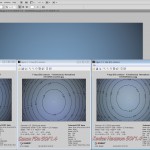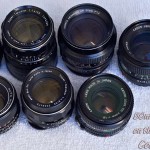50mm prime lens comparison, shot on Sony a7R, first round
This first round of 50mm SLR camera lens testing will cover some of the fast f/1.4 glass. Four lenses total, all 50/1.4; Pentax Super Takumar, Canon FDn, Konica Hexanon AR, and SMC Pentax.
Here are the vignetting test results on the top three finishers, at f/1.4. They were all pretty close.
Super Takumar: -2.84(f-stops)
Canon FDn: -2.7(f-stops)
Konica Hexanon: -2.79(f-stops)
The Pentax Super Takumar had a slightly slower shutter speed, but all RAW files were adjusted to be at roughly the same exposure, before processing. Only four of the lenses in the photo below have been tested so far, the slow glass will be covered later.

50mm lens Vignetting test: Super Takumar, Canon FDn, Konica Hexanon AR, Pentax SMC Takumar, on the Sony a7R
Ease of focus at long distances: The 50mm focal length, at this subject distance, is close enough to be using the second stage of Sony a7R EVF magnification. The “5610” street number on the back of the building is the focus point, as usual. All of these lenses worked fairly well for focusing, although the Super Takumar was probably better at focusing than the Canon FDn was.
Lens contrast: *Wide open* There was significant veiling haze over the Super Takumar, and to a slightly lesser extent, the Konica Hexanon AR, which made it hard to see much contrast at all. One point each for the Canon FDn and the SMC Takumar, but not by much. *f/8* It’s difficult to make a solid judgement here. There are different exposures and different lighting conditions; the SMC Takumar has this yellowish earthy tone to it, possibly due to a radioactive element, that is distracting. You’ll have to decide for yourself. More on the radioactive elements at this link; note that the Konica Hexanon AR 50/1.4 that was tested here has the f/16 max aperture/green AE markings that are on this list: http://camerapedia.wikia.com/wiki/Radioactive_lenses
Sides of the images: *Wide open* f/1.4 makes picking the winner a bit easier. The SMC Takumar and the Konica Hexanon both go down hard here, they appear to have field curvature issues on the sides, so they are out for full frame use. It looks like it might be a possible lens design issue, so you may not find relief in different copies of the same design. Of the two remaining lenses, the Canon FDn is the strongest of the four on the left side, but it is soft on the right side. Two points for the Super Takumar, and one point for the Canon FDn, on the hope that a different copy doesn’t have the same right-side defect.
Center of the images: *wide open* The Super Takumar 50/1.4 beats the Canon FDn 50/1.4, one point; see the “5617” street number, on the front of the building, second street back from the camera, upper center of the image. The question here is whether or not the Canon lens is perfectly focused. *f/8* Things are a lot more competitive, you be the judge.
Summary: The Super Takumar moves forward, but with reservations about whether or not the left side is as good as that model of lens actually gets. The slightly soft right side of the Canon lens makes one wonder what a perfect copy of it would look like. It has less veiling glow than the Super Tak does wide open, so the potential is there.
**Here are the test images, they are 21-29mb in size, **be sure and view at 100% size**:
Dan Euritt



